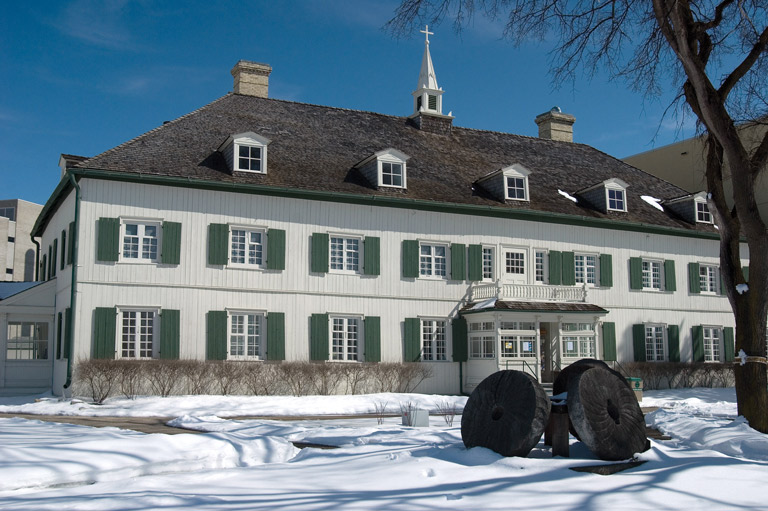The Riel Deal

Coming up the snow-covered path to Winnipeg’s St. Boniface Museum on a sunny but frigid January day, I can’t help but think about the four hardy Grey Nuns who first came to Manitoba in 1844 to tend the people of the Red River Colony. I think it’s safe to presume that their training couldn’t have prepared them for the harsh prairie winters.
The museum is housed in what was once the convent of the Grey Nuns, who came from the Sisters of Charity order at the Hôpital Général in Montreal. (Their nickname comes from their grey habits). Construction on the convent began a year after their arrival, and the nuns took occupation of the building on December 31, 1847. The long, three-storey convent, built in the Red River frame construction style and painted white with green trim, is the oldest building in Winnipeg.
I’ve arrived to take a tour led by museum director Philippe Mailhot. The mandate of the St. Boniface Museum is to preserve the history of French Canadians and Métis in western Canada.
That history begins with the fur trade.
“Whether it was the Hudson’s Bay Company — once they began to operate in the interior — or the North West Company, the bulk of the labour force was French-speaking,” says Mailhot.
The Métis are mostly descendants of French fur traders and Aboriginal women. Along with retired traders, they were the main residents of the Red River area that later became Winnipeg.
The museum contains the largest collection of artifacts relating to Louis Riel, the Métis founder of Manitoba. Among the most bizarre items are a few strands of Riel’s beard. They were pulled from his chin after he was hung for treason on November 16, 1885, in Regina after opposing the Canadian government in a fight for Métis rights.
Mailhot points to the building as a significant artifact in itself. Its creaking floors and a lingering smell of wood recall earlier times. The marks of an axe on a ceiling joist on the second floor are a tangible reminder of the men who constructed the building over 160 years ago and one of the remarkable ways its builders and earlier inhabitants live on thanks to the structure’s careful preservation.
The museum also works to preserve the history of the various incarnations of the St. Boniface Cathedral, just down the road from the museum. Five houses of worship have stood on this site. The latest version, designed by architect Étienne Gaboury, is modest in size and modern in design. Notable are the starkly beautiful art of the stained glass windows and the terra cotta-style statues of Jesus and Mary mounted on the wall behind the altar. Mary, representing Our Lady of Red River, is dressed in moccasins, a shawl, and a Métis sash, an outfit Métis women commonly wore to church in the 1800s.
The present-day church sits within the stone shell of the massive previous cathedral. Arguably one of the most impressive buildings in Winnipeg, its remains are an imposing example of French Romanesque architecture. Built between 1905 and 1908, the cathedral was largely destroyed by fire in 1968.
Mailhot hopes to make the public aware that the museum can supplement their cathedral visit. Displays in the convent’s chapel contain artifacts and information about the St. Boniface mission, founded in 1818, and the museum conducts guided tours of the cathedral and cemetery, which contains the grave of Louis Riel.
The St. Boniface Museum is great to visit during the Festival du Voyageur, a ten-day annual celebration of the fur trade that’s well worth checking out. The festival runs in the middle of February, but the museum’s guided tours are available year-round.
Other area historical attractions include North America’s oldest stone fur-trading fort. Lower Fort Garry is located about a half hour drive north of downtown Winnipeg. Spring and summer walking tours of Winnipeg’s Exchange District, once the financial and industrial hub of Western Canada, run every day from June to Labour Day.
Also of interest are the Manitoba Museum and the Costume Museum of Canada, which contains clothing dating back four centuries.
Themes associated with this article
Advertisement
You might also like...

Canada’s History Archive, featuring The Beaver, is now available for your browsing and searching pleasure!

Beautiful woven all-silk necktie — burgundy with small silver beaver images throughout. Made exclusively for Canada's History.







